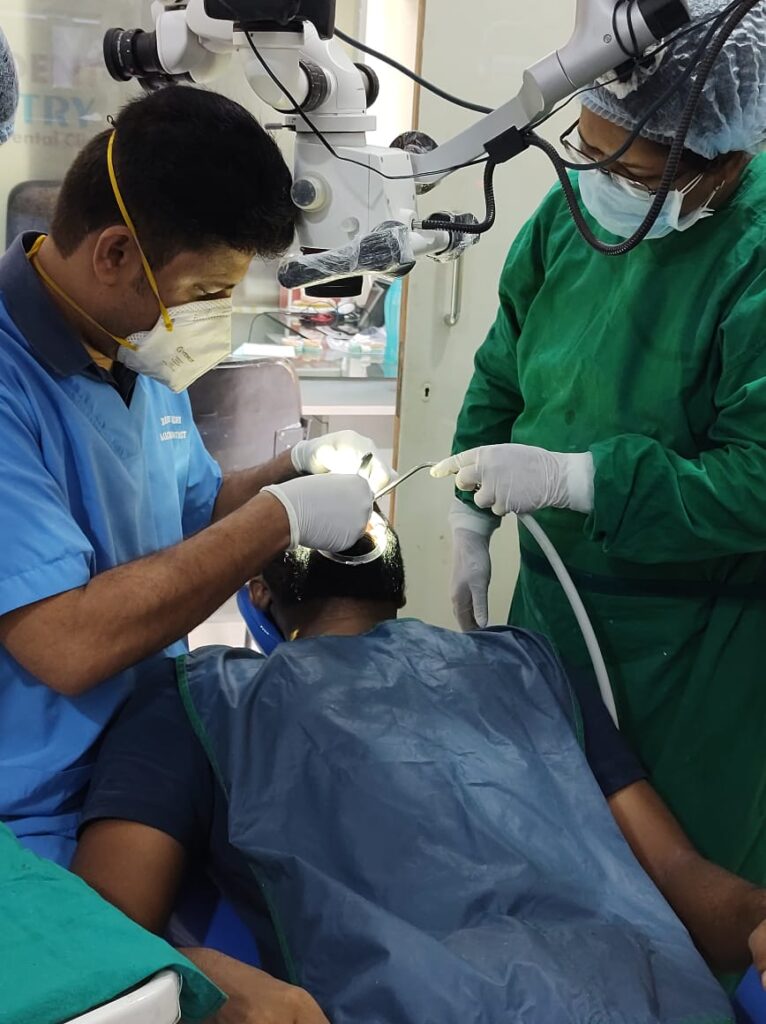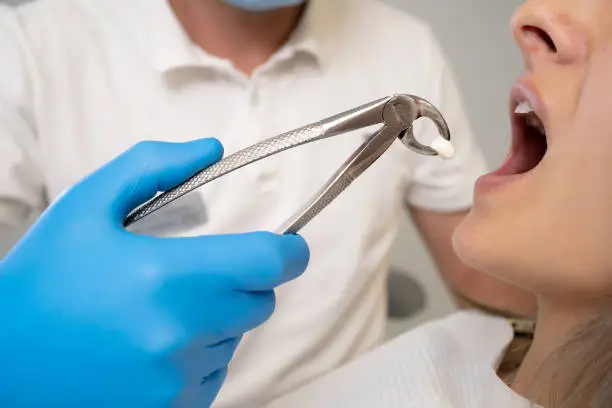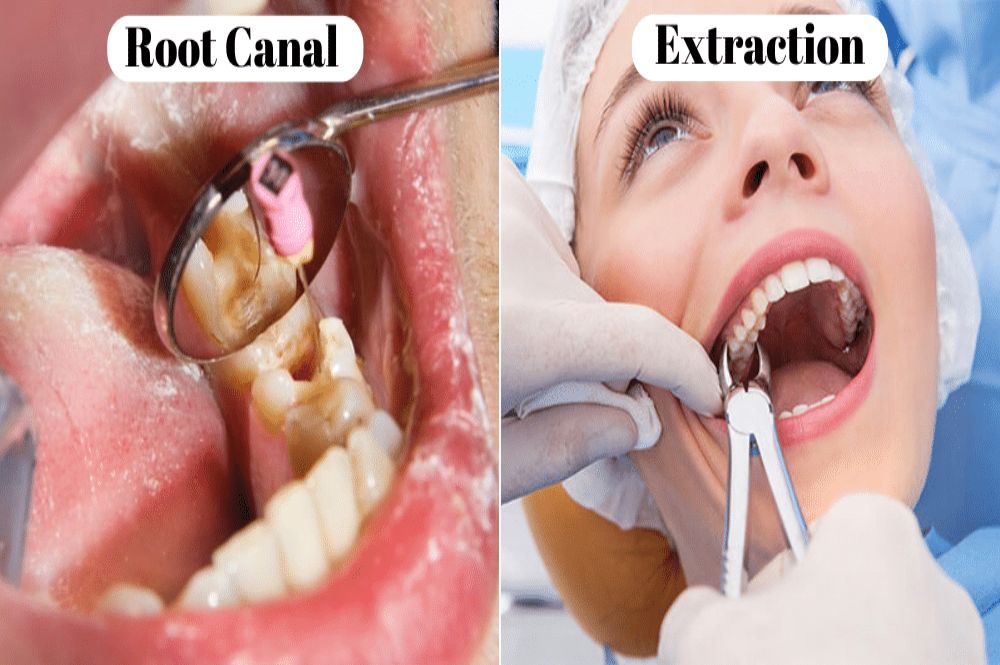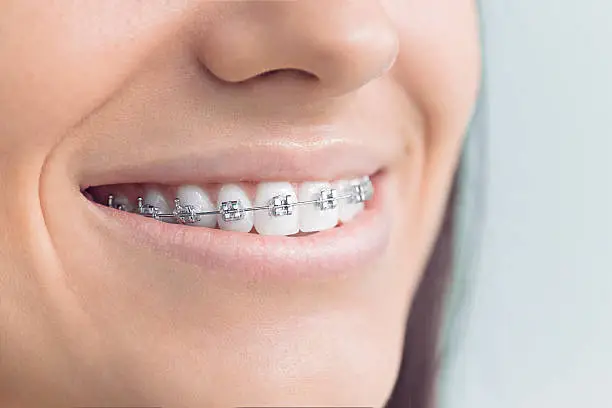When dealing with a severely damaged or infected tooth, you may be presented with two main treatment options: root canal therapy (RCT) or extraction. Both have their pros and cons, depending on the specific circumstances. Let’s break down each option and compare them in detail to help you understand which one might be the better choice for you.
Root Canal Therapy (RCT)

A root canal is a procedure designed to save a tooth that is severely damaged or infected. The process involves removing the damaged or infected pulp (the soft tissue inside the tooth), cleaning and disinfecting the inside of the tooth, and then sealing it to prevent future infection.
How a Root Canal Works:
Diagnosis: The dentist or endodontist will take X-rays to assess the extent of the damage or infection.
Anesthesia: The area around the tooth is numbed with a local anesthetic.
Access: A small opening is made in the top of the tooth to access the pulp chamber.
Cleaning and Disinfection: The infected or damaged pulp is removed, and the inside of the tooth is cleaned and disinfected to eliminate any bacteria.
Filling: The empty space is filled with a biocompatible material (usually gutta-percha) to seal the tooth.
Restoration: The tooth is typically restored with a crown to restore its strength and appearance.
Pros of a Root Canal:
Preserves the Tooth: The main benefit of a root canal is that it allows you to keep your natural tooth, which is often the best choice for long-term oral health.
Prevents Extraction Complications: Keeping the tooth means you avoid the potential need for implants or bridges later on, which can be more costly and time-consuming.
Natural Function: Since you’re saving your tooth, it functions just like a healthy tooth, which makes chewing and speaking easier.
Relief from Pain: A root canal eliminates the infection that’s often causing pain, which can lead to immediate relief.
Cons of a Root Canal:
Potential for Future Issues: If the tooth develops further problems (such as re-infection), it could require retreatment, or even extraction in the future.
Weakening of the Tooth: After a root canal, the tooth can become brittle because the pulp is no longer nourishing the tooth. This is why a crown is often placed, but the tooth is still more susceptible to fractures.
Tooth Extraction
A tooth extraction involves completely removing a damaged or infected tooth from its socket in the jawbone. This is typically done when a tooth cannot be saved by a root canal, or if the tooth is too decayed or compromised to be repaired.
How an Tooth Extraction Works:

Tooth Removal: The dentist will anaesthesize the toth and withthe use specialized tools to loosen the tooth and remove it from the socket.
Pros of Extraction:
Simple Procedure: For severely damaged teeth that cannot be saved, extraction can be a quicker and simpler solution, often requiring only one visit
Cons of Extraction:
Loss of Natural Tooth: The most significant downside is that you lose your natural tooth. This can affect your smile, the functionality of your mouth, and your bite.
Replacement Required: After extraction, you may need a dental implant, bridge, or denture to replace the missing tooth, which can be costly, time-consuming, and invasive.
Bone Loss: When a tooth is extracted, the bone in the area may begin to resorb (shrink), which can cause further oral health issues down the line, especially if you do not replace the tooth.
Potential for Shifting Teeth: Missing teeth can cause surrounding teeth to shift, leading to bite problems and misalignment.
Which Is the Better Choice?
The decision between a root canal and an extraction depends on several factors:
1. Extent of Tooth Damage
Root Canal: If the tooth has significant decay or damage but the root and surrounding structures are still intact, a root canal is generally the best option. It saves the natural tooth, which is always preferred when possible.
Extraction: If the tooth is severely fractured, the root is damaged beyond repair, or if there is an advanced infection that has spread to the bone, extraction may be necessary.
2. Patient’s Oral Health and Preferences
Root Canal: Ideal if you want to preserve your natural tooth and avoid the need for future replacements.
Extraction: If the tooth is too damaged to be saved or if you don’t want to undergo the process of a root canal, extraction might be the better option. It could also be the choice for patients who don’t want to invest in the future cost of maintaining a root-filled tooth (e.g., crowns, potential retreatment).
3. Long-Term Considerations
Root Canal: A root canal can last many years (even a lifetime with proper care). If the tooth is successfully treated, you won’t need to worry about it for a long time. However, over time, the tooth can become brittle and may need to be restored with a crown.
Extraction: While extraction is sometimes the quicker fix, it’s often followed by the need for a dental implant, bridge, or denture to replace the lost tooth. This could involve additional costs and treatment time.
4. Cost and Time
Root Canal: Root canals are typically more expensive upfront, especially when factoring in the cost of the crown needed afterward. It may also take more time, as multiple visits may be required.
Extraction: While extractions can sometimes be less expensive upfront, replacing the missing tooth with an implant or bridge may be costlier in the long term.
In Summary:
Root Canal is generally preffered in long run
Extraction might be the better choice if the tooth is too damaged or if the cost or time involved in saving the tooth is prohibitive. However, extraction often leads to the need for additional restorative procedures down the line.
Ultimately, the “better” choice depends on your specific situation, including the condition of the tooth, your overall oral health, and your personal preferences. It’s essential to consult with your dentist or endodontist, who can evaluate your case and help guide you toward the best decision for your dental and overall health.
Frequently Asked Questions (FAQs)
1. What is the main difference between a root canal and a tooth extraction?
A root canal treatment saves your natural tooth by removing infection and sealing it, while a tooth extraction completely removes the tooth. Root canals preserve your smile and chewing ability, unlike extractions which may require replacement.
2. Which is better – root canal or tooth extraction?
In most cases, a root canal is better because it preserves your natural tooth and prevents jawbone loss. Tooth extraction is only recommended when the tooth is too decayed or damaged to be saved.
3. Is a root canal painful compared to extraction?
Both root canal and tooth extraction are performed under local anesthesia, so they are virtually painless. Most patients experience faster and more comfortable recovery after a root canal.
4. What is the cost of root canal vs. tooth extraction in Pune?
The root canal treatment cost in Pune ranges from ₹3,000 to ₹8,000, while tooth extraction costs ₹1,000 to ₹3,000. However, if you need a dental implant or bridge after extraction, overall costs increase.
5. How long does recovery take after root canal or tooth extraction?
Recovery from a root canal usually takes 1–2 days, while tooth extraction can take 3–5 days or more, depending on the complexity and aftercare.
6. Can a missing tooth be replaced after extraction?
Yes, after tooth extraction, you can replace the missing tooth with a dental implant, bridge, or denture to restore proper function and smile aesthetics.
7. When should you choose tooth extraction over a root canal?
Choose tooth extraction when the tooth is severely infected, fractured, or beyond repair, or when the infection has spread to the bone and cannot be treated by a root canal.
8. Why choose Microdent Dentistry in Pune for root canal treatment?
At Microdent Dentistry, Pune, experienced dentists use advanced technology and painless techniques to perform precise and long-lasting root canal treatments, helping you preserve your natural teeth safely and effectively.
Call Now: +91 72640 08000 / +91 90216 81032
Find Clinic here: Get Direction
Location: Ground Floor, block 4, Sarvadarshan Co-op Housing Society Ltd Abhinav Chowk, Karve Rd, opp. Saraswat Bank, Nal Stop, Pune, Maharashtra 411004




